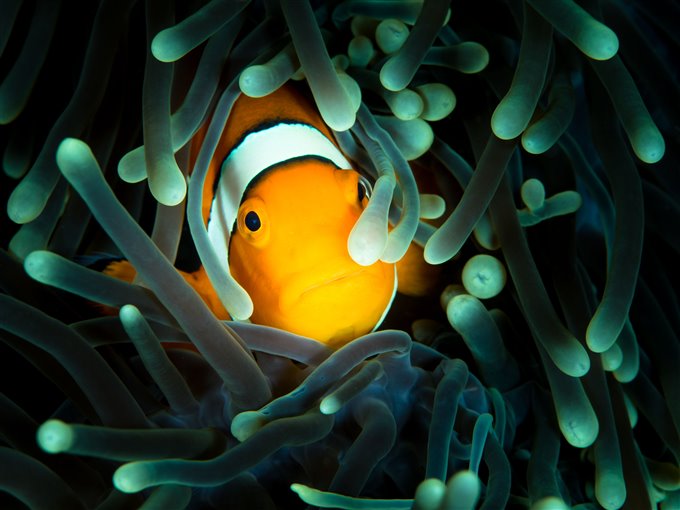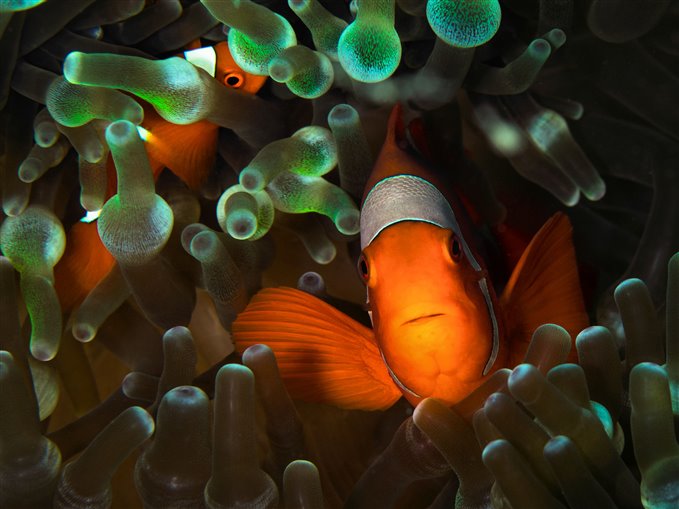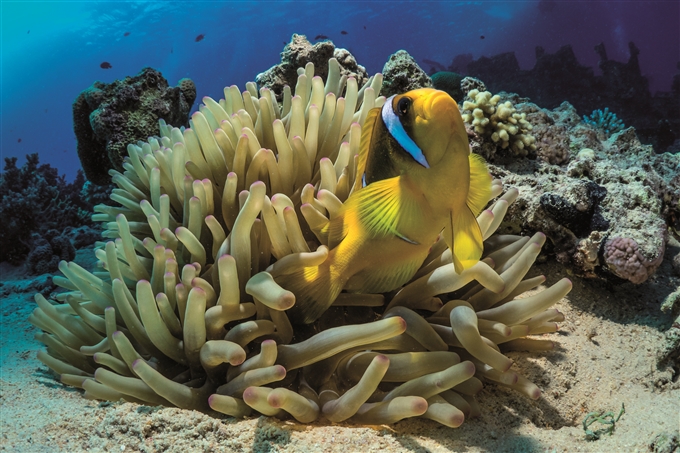Since the beginning of this century, to be more precise since the release of the Disney’s movie, the most famous fish in the world has been the clownfish, of course the one named after the famous captain’s name Nemo. His influence on mass consciousness is so strong that some even blame him for the drop of carp sales in Poland. Is that a fact? I don’t know. Undoubtedly, the drop is clear, but it started shortly before the movie’s premiere. Still, it accelerated rapidly after the cartoon movie was released.

David Benz • OM-D E-M1 • M.ZUIKO DIGITAL ED 60mm 1:2.8 MACRO
• PT-EP11 • PPO-EP01 • 2 x UFL-3
By ichthyologists, this loveable creature with astonishing features is classified as part of the Amphiprioninae, a group consisting of 27 species living in the coral reefs of the Indo-Pacific. It has different names: clownfish, clown fish, amphiprion or anemonefish. The first two names refer to the colouring of the fish, which is associated with the popular circus comedian. The name anemonefish, however, refers to its strange lifestyle. All representatives of this species live in symbiosis with an anemone – they fancy 10 specific types of anemones and tend to live in groups . Many clown’s customs still remain a mystery to us.
The anemone is a coral. It has antennae with thousands of nematocysts – a dangerous weapon that can handle an animal much bigger than the 15-centimetre-long clownfish. Why does it not harm its habitant then? Well, we don’t know exactly. It is believed that in the process of evolution, clownfish produced mucus similar to the secretions of the anemones. This secretion protects corals from the attacks of their own nematocysts. Our fish used it wisely. But it is not as easy as it sounds because each of the 10 anemone’s species has its own individual type of mucus. The immunity to the host’s nematocysts is completely useless in contact with other anemones and it is not innate. The fish has to learn it. It must produce exactly the same mucus as the one produced by its future host. So, it begins to learn gradually. Firstly, it swims up to the potential host and touches it with the tip of its fin. Then it gets deeper and deeper until it is completely immune. Of course, a mistake in the “address” and falling into the embrace of another anemone leads to death. Moreover, the acquired immunity is not permanent. If the clownfish stays away from its anemone for a longer period of time, the whole process will have to start over. The benefits of such cooperation, called symbiosis or protocooperation, are mutual but not essential to live. You might get the impression that this symbiosis is more beneficial for the clownfish, which are practically not encountered outside the anemones, while the anemones are quite commonly seen without any clownfish around.

David Benz • OM-D E-M1 • M.ZUIKO DIGITAL ED 60mm 1:2.8 MACRO
• PT-EP11 • PPO-EP01 • 2 x UFL-3
Gender is another surprising feature of the clownfish. They usually live in pairs, although sometimes they form small groups called shoals. The pair, usually a larger female and a smaller male, “bundle a nest” in an anemone. Every 27 days, in a lunar rhythm, under the safe cover of the anemone’s arms, the female lays about 25,000 roe eggs. After 7 to 10 days, in the nocturnal darkness, hatching takes place and larvae float to the surface layers. When they grow up, and only a few of them manage to do that, they go back to the bottom to search for their anemone. At first they will look for small species and then for the right host. All young clowns are male. Only later, some of them will change into females. How does this happen? We don’t know exactly either. Clownfish living in exceptionally large anemones form small groups. Their structure is always the same: One female and several males. The female spawns with one dominant male. If it dies, an amazing thing happens: Her former partner becomes a female and his place is taken by the male which is second in the line. All the others move in line by one position to being a female. The purpose of such a mechanism is obvious – the maintenance of species. What remains unknown is how they do it.
Enough theory and science – let’s talk about shooting.

Marcin Dobas • OM-D E-M1 • M.ZUIKO DIGITAL ED 8mm 1:1.8 Fisheye PRO
• PT-EP11 • PPO-EP02 • 2 x UFL-3
Underwater photography is fascinating. We can share an extremely interesting world that others would not be able to see without our images. And so, we can also share the world of Nemo. The photo of this beautiful clownfish was taken with a wide-angle lens. This allowed eliminating the long water column between the camera and the object. The more water between the lens and the photographed object, the worse the quality of the final picture will be. When deciding on a wide-angle lens, we reduce this distance, so that the amount of slime in front of the subject is much smaller and the image becomes clearer and sharper. The wide-angle lens also affects the depth of field (it will be larger than when using the longer focal length) and the perspective (we will be able to show more space behind the subject). It will also be easier for us to illuminate what we want to photograph. And finally the principle of the "f/8 aperture", as the Anglo-Saxons say “f eight, one meter and be there”. This principle gives interesting effects, especially in combination with a wide-angle lens. Turn on your flashlight to illuminate a clownfish which is one meter away from you. Set the f/8 aperture. It is worth configuring everything before going into the water. Why? In general, a few seconds after the dive, you will notice dozens of objects that you will want to photograph. If you set everything before diving, you will have a good chance not to miss them and capture the small orange wonder of nature.
Comments
Show more comments (0)